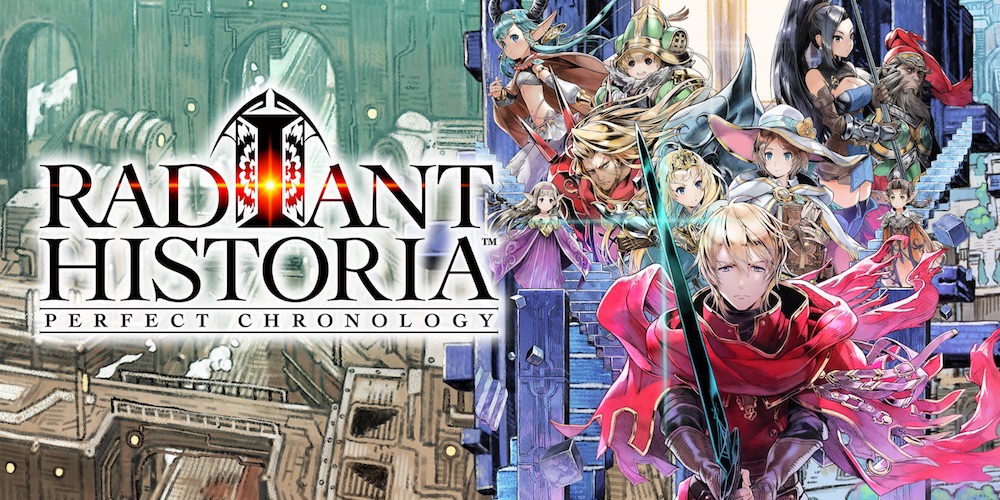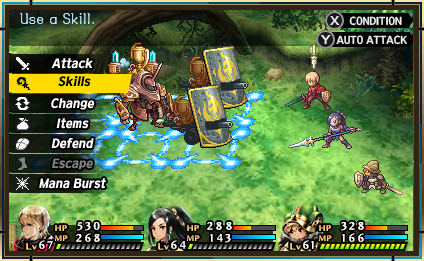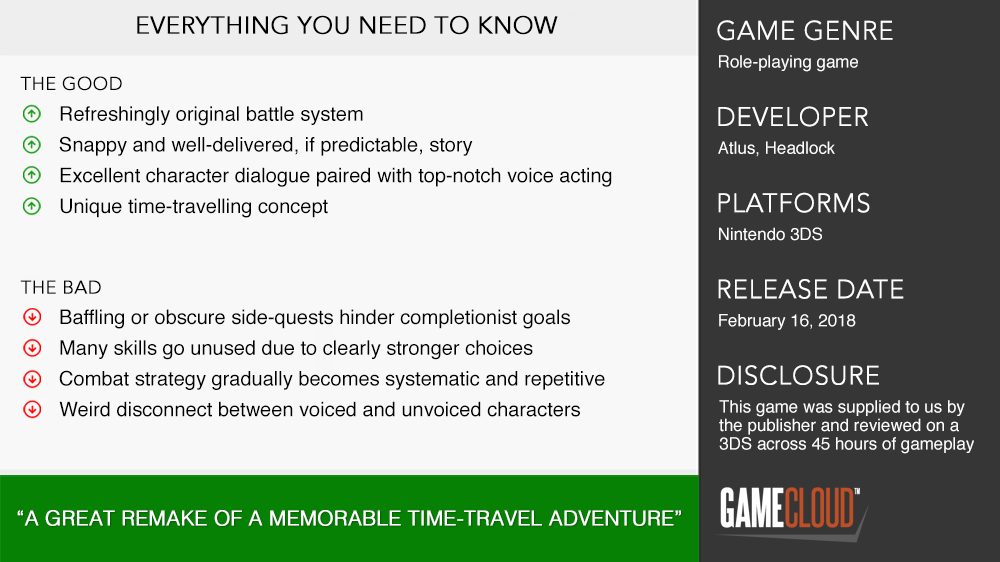
In an era when remakes are about as frequent as brand new games, I think I can be forgiven for initially writing off Atlus and Headlock’s latest release, Radiant Historia: Perfect Chronology. Thinking it yet another JRPG amidst the many, I hadn’t really dug into it until shortly before its release. My interest was quickly piqued during my preliminary research, and I was excited to see if my fresh experience lived up to the reputation the former had achieved. I’ll be talking from this point of view, so apologies to any returning veterans out there: I’ll quickly discuss the changes right before the conclusion.
I can’t really talk too deeply about the overall setting of Radiant Historia, as it’s one of the few games that offer a substantial ‘discovery’ experience. Over the entire course of your journey, you’ll be learning more about the people, the customs, the history. Through this, you’ll be driven forward not just by the plot but your desire to know more about the world and to understand its inhabitants. I feel this is one of the more powerful things any game can do, creating a second layer on which you interact with it, as an eager explorer and not just a player.
Due to its spoiler-heavy nature, I’ll also refrain from getting too much into the plot and stick to some big-picture points. I hold high value in anyone capable of being efficient with words, which is apparently a talent of the writers of the game. While the story’s big swings are relatively predictable, it moves through the tale with such a pace as to keep you interested with more to see and more to know. There’s a lot of story content packed in here, and it’s delivered in neat and easy to digest segments at a regular frequency.

What I do feel I need to discuss is the time-travelling system that Radiant Historia has created. The core of your entire experience is through two distinct timelines, established by one pivotal decision early on. Both timelines are kept relevant the whole way, as you’ll be required to do certain things in one to proceed in the other. This cleverly avoids the more common method normally used to tackle these games, completing one in full before returning to the other while integrating the reason for this into the story.
This is not to say that the tale disregards the numerous possibilities that need exist in any story about decisions and consequences, it just addresses them succinctly. There are multiple points in which you are presented with two options: a correct one to proceed with the story, and an incorrect one which will result in a brief description of how this path ultimately resulted in the failure of your mission. While the binary ‘right versus wrong’ choice has bothered some, I find it focused. Radiant Historia wants to discuss the interplay of two specific timelines and does so directly, briefly acknowledging the outcomes of other options.
What really makes the overall tale particularly memorable is the cast of characters, a diverse group who avoid the “trait-centric” nature of many similar crews. Each character has a range of different views and opinions that come out in different ways, meaning you’re always interested in what they have to say. This is further enhanced by some particularly strong dialogue writing and many powerful voice acting performances. I’d like to particularly acknowledge how much the voice acting defined the main character, Stocke, for me. The ‘introverted character who cares’ archetype is often played too blandly, but I felt the voice carried enough emotion without becoming forced. For what it’s worth, I listened to the full dialogue for the entire game, a feat I rarely achieve.

I do have one particular complaint about the decisions on vocals, and, while it could be considered minor, it directly disrupted my immersion. Characters fall into two categories: voiced and unvoiced. Voiced characters are given audio in every way, from the main story to the smallest NPC dialogue. Unvoiced characters are never voiced for any reason, not even at critical plot points, only pulling from a small pool of samples. This complete disconnect never failed to throw me, especially after a lengthy discussion between multiple voiced characters. I repeatedly caught myself waiting for them to start talking, before realising a character had no voice.
Combat managed to pull some unique tricks out of the bag, producing a handful of systems that I’ve not seen before. Firstly, enemies exist on a 3×3 grid and are shuffled around and grouped up by your moves, with your ultimate goal being either positioning them near the back to minimise their damage potential or grouping them up to hit them all at once. Secondly, all combatant turns use the classic “turn list,” but with the significant change that your party members can choose to change their turn with any other combatant to swing the battle flow in their favour. With these systems combined, I was forced to consider battle tactics from an angle that was delightfully new to me.
While this combat captured me quickly, it is far from perfect. By the end of your experience, all of your cast will be suffering from severe skill bloat due to a number of skills that are too specific to be useful and rarely strong enough to justify their difficulty to execute. While I could spend some turns setting up the field to suit this new fancy move, I would often be better off using the strong actions I’d been using since the beginning. I took out the final boss of the game with the liberal use of the first ever direct-attack move obtained by the main character.

The system by which you travel through time is well implemented for the most part. The two timelines are easy enough to navigate and the Perfect Chronology added a ‘fast-scroll’ that I can’t imagine having to live without. The one major letdown is how side-quests are worked into this: randomly displayed somewhere near the point that the quest is obtained. Not only does this make locating the quest details difficult, but it also means that there is absolutely no way to find out where any missing side-quests are, beyond randomly flitting about the extended history. This will prove a massive obstacle if you hope to reach the true ending, and I ultimately decided to look up the location of my last three quests.
Along with the fast-scroll on the timeline screen, there are a few other changes. Most notable to me as a new player is the Vault of Time, essentially a “grinding” mode, but executed with direction and purpose. Support Skills allow out-of-combat party members to assist in their own ways, such as random buffs and heals. The new character art is attractive and has a distinct style to it. I’ve compared it to the original and would definitely say this new style is more my taste.
“But wait, Ben,” you might saying, “are you going to finish without discussing the new story content?” Quite frankly, I feel like I could, as I enjoyed my entire time with the game but only up to the inclusion of the new content. See, it’s offered in two modes, “Perfect” for fans of the old game and “Append” for brand new players like me. Unfortunately, Append is not a functional way to experience this content. When I finally I had access to the content, I had already out-levelled all of the it, except for the very last fight, and thus had no challenge and minimal interest. I feel that returning players will find the “Perfect” mode vastly more enjoyable, but other “Append” players will have to be particularly eager to see the absolute ending of the story to persist through this lengthy time-sink stapled onto the end.

While Radiant Historia: Perfect Chronology offers a battle system unlike any others you’ve likely played, what is really on offer here is a well-told story with memorable characters. If you’re one to skip cutscenes or power through dialogue boxes, you’re going to miss a lot of what is charming about this game and be put off by battles that become less interesting as you progress. On the other hand, curious and patient players will find meaningful character dialogue voiced by a talented cast, succinct storytelling to keep your interest, and a world very different to ours to learn about.











